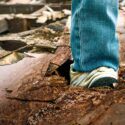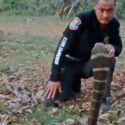You’re camping, and it’s dusk. As you gather firewood, one of the sticks moves. It’s not a stick. It’s deadly black mamba. The snake raises its head more than 1 m (4 ft) off the ground.
It strikes like lightning, attacking you again and again, then slithers away. What could you do to survive?
The Black Mamba, AKA Kobe Bryant, stood at the height of…wait. That’s the wrong black mamba. Found throughout eastern and southern regions of Africa, the black mamba snake is one of the most feared, most deadly snakes in the world. And it may try to intimidate you by extending its neck flaps.
At full speed, a black mamba can travel at 19 km/h (12 mph). That’s faster than most people can run. They’re also the longest venomous snake in Africa, and the second longest in the world, averaging 2.4 m (8 ft) long. But they have grown up to 4.3 m (14 ft).
If you want to survive your trip to Africa, you might be wondering about a few things. Are black mambas black all over their bodies?
Do these snakes hang out alone or travel in groups? And how fast can you die from a black mamba’s venom?
In 2017, a black mamba knotted itself around a Kenyan woman’s leg. As she tried to get it off, it bit her three times. She passed out before arriving at the nearest hospital. It was 45 minutes away. Luckily, the medical staff had antivenom, and it saved her life. But what could you do to increase your chance of surviving a black mamba attack?
Step 1: Dress for Success
Just two drops of black mamba venom could kill you in as little as 20 minutes. If you’ll be walking through bush or long grass, a black mamba snake could be there too. Wearing thick, long clothes such as pants, a shirt, or a jacket could help protect you. Wearing hiking or work boots should help protect your feet and ankles.
Step 2: Practice Social Distancing
Black mambas are territorial, so don’t go looking for a fight. If you see or hear one, leave it alone. Do not go near the snake, and if it tries to escape, let it. If it feels cornered, you’ll face its wrath. And if you see one that looks dead, leave it alone too. Some snakes “play dead” to lure their prey.
Step 3: Know their Hiding Places
These fearsome killers are surprisingly shy. They like places where they can hide, rest, and not be disturbed. This includes lazing under rocks, inside dead tree stumps, and under logs. They also like caves and empty termite mounds. But they hunt during the day, so watch out.
Step 4: Don’t Be Fooled by Their Name
The inside of their mouths are blue-black, but a black mamba’s body is a brownish color, ranging from olive to greyish tones, with paler bellies.
Step 5: Control Your Breathing
You were so busy watching for one snake that you didn’t see the others. Although they’re usually loners, you might encounter two, or a small group, of black mambas. This is hard, but if one bites you, staying calm can help you stay alive. You’ll want your breathing and heart rate to be as slow as possible, to slow the venom’s spread through your body.
If a black mamba bites someone else, help keep their breathing stable as well. Remove any clothing, rings, necklaces, and other objects that could constrict their breathing.
Step 6: Get Antivenom
Within 20 minutes, toxin starts acting on the nervous and cardiovascular systems. You might pass out or become paralyzed. And without antivenom, you’re guaranteed to die. Scientists have developed an antivenom that counteracts the 10 most venomous snakes in Africa.
It has to be injected into your veins because muscles don’t absorb it well. It’s also important not to inject into or around the bite site.
And you may need equipment to help you breathe while the antivenom takes effect. You’re lucky. Friends got you to a hospital, they had the antivenom, and over time, the antivenom will ease your muscle paralysis. You’re going to live. And even though black mamba snakes are big, other reptiles are much, much bigger.
Sources
- “Black Mamba Facts”. Jessie Szalay. 2021. livescience.com.
- “Why knowing what black mamba venom does to the human body is crucial”. 2019. The Conversation.
- “Snakebit: Surviving The Black Mamba”. Dana, Highes. ABC News.
- “Black Mamba (Dendroaspis Polylepis Polylepis)”. 2021. toxicology.ucsd.edu.
- “Prevent Or Respond To Snake Bite|Natural Disasters And Severe Weather”. 2021. cdc.gov.
- “This Woman Survived One Of The Deadliest Snake Attacks”. 2017. Huffpost Canada.
- “Black Mamba ~ About | Nature | PBS”. 2011. Nature.




























E choke